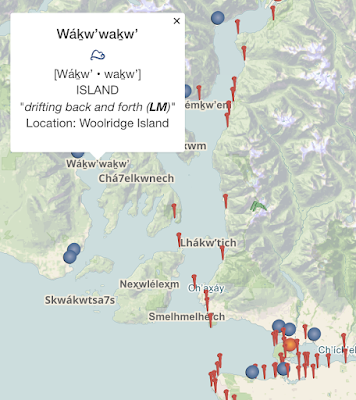Karen Pinto's new book Medieval Islamic Maps; An Exploration covers a very overlooked school of cartography.
These maps are more representational than geographic, following the early Christian T-O maps. In an interview, Pinto describes the typical world map as having the form of a bird. The map on the cover puts south at the top. The white land areas are the bird's features: Africa is the upper wing, the Arabian Peninsula is the head, Asia is the body and Europe (the tiny triangle in the lower left) is the tail. Here is another version by Al Istahkri from cartographic-images.net circa 977 AD.
The large water body on the left side is the Persian Gulf and Indian Ocean. The teardrop shaped water on the right side is the Mediterranean Sea. The Nile is shown sticking up from there while below the Mediterranean is the Bosporus Strait. Rivers coming down from the Sea on the left are the Tigris and Indus. Both seas are shown containing three large islands, it is not always agreed which ones they are. Other important water bodies in the lower half of the image are the Caspian and Aral Seas. Another image from cartographic-images.net helps translate the place names.

There is no scale on these maps but Al Istahkri lists distances between places in marhalah (a day's journey.) A journey through the inhabitable world was 210 days. The far north and south were considered uninhabitable because extreme cold and heat respectively. The southern hemisphere was unknown to these travelers.
Pinto discusses how scholars have often belittled these maps for their simplicity while ignoring that they are iconographic representations, meant to promote a common world perception. The simple forms also made them easy for traveling scholars to reproduce and bring back to their home libraries.
These maps are more representational than geographic, following the early Christian T-O maps. In an interview, Pinto describes the typical world map as having the form of a bird. The map on the cover puts south at the top. The white land areas are the bird's features: Africa is the upper wing, the Arabian Peninsula is the head, Asia is the body and Europe (the tiny triangle in the lower left) is the tail. Here is another version by Al Istahkri from cartographic-images.net circa 977 AD.
The large water body on the left side is the Persian Gulf and Indian Ocean. The teardrop shaped water on the right side is the Mediterranean Sea. The Nile is shown sticking up from there while below the Mediterranean is the Bosporus Strait. Rivers coming down from the Sea on the left are the Tigris and Indus. Both seas are shown containing three large islands, it is not always agreed which ones they are. Other important water bodies in the lower half of the image are the Caspian and Aral Seas. Another image from cartographic-images.net helps translate the place names.

There is no scale on these maps but Al Istahkri lists distances between places in marhalah (a day's journey.) A journey through the inhabitable world was 210 days. The far north and south were considered uninhabitable because extreme cold and heat respectively. The southern hemisphere was unknown to these travelers.
Pinto discusses how scholars have often belittled these maps for their simplicity while ignoring that they are iconographic representations, meant to promote a common world perception. The simple forms also made them easy for traveling scholars to reproduce and bring back to their home libraries.












